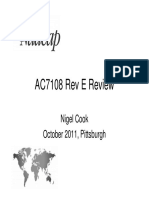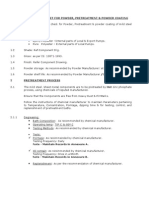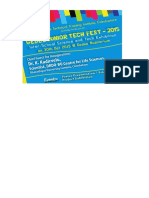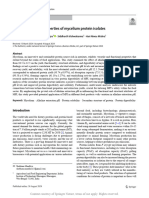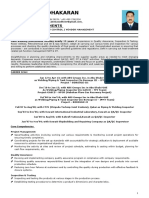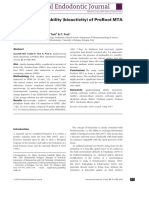Powder Coating 1210
Powder Coating 1210
Uploaded by
sansagithCopyright:
Available Formats
Powder Coating 1210
Powder Coating 1210
Uploaded by
sansagithOriginal Description:
Copyright
Available Formats
Share this document
Did you find this document useful?
Is this content inappropriate?
Copyright:
Available Formats
Powder Coating 1210
Powder Coating 1210
Uploaded by
sansagithCopyright:
Available Formats
Powder Coating
POWDER COATING
Powder coating is a finishing technology where a
decorative and highly protective coating can be applied to a wide
range of products.
The process involves spraying finely ground, electro-statically
charged particles of pigment and resin onto a surface to be coated.
The charged powder particles adhere to the
electrically grounded surfaces and then are
heated and fused into a smooth coating
in a curing oven.
WHY POWDER COATING
Superior Appearance
Mechanical Resistance Properties
Corrosion Resistance
Solvent Resistance
Highly durable: chip, scratch, fade and wear resistant
Ready to use and require
no mixing, Solvents,
or catalysts
Liquid Finishes Vs. Powder Coating
Solvents Necessitate venting, filtering, and solvent
recovery systems that is not necessary in powder
coating.
Liquid Spray Coating achieve material usage of
20-85% while powder coating has a Material
usage of 95-98%
Liquid overspray is lost in filters
while 99% of Powder overspray
is collected and reused
POWDER TYPES
Thermoplastic
Powder melts and flows to form a film.
Continues to have the same chemical composition when it solidifies
Will re-melt when heated.
Thick coating surface and not in same market as liquid paint.
Examples
:
Polyethylene
Polypropylene
PVC
Thermoset:
Powder melt flow and cross-link chemically to products
Cured coatings have different chemical structures than the basic
resigns.
Will not re-melt when reheated
Can produce thin paint like coating of 0.001 0.003 inch thick.
Examples
Epoxy
Hydroxyl polyester (urethane)
Acrylic Urethane
PROCESS
POWDER COATING PROCESS
The powder coating process involves three
basic steps:
Part
preparation or the pre-treatment
The powder application
Curing
PRE-TREATMENT
Removal of oil, soil, lubrication greases, metal oxides,
welding scales etc. is essential prior to the powder
coating process
Chemical pre-treatments involve the use of phosphates
or chromates in submersion or spray application
Another method of preparing the surface prior to coating
is known as abrasive blasting or sandblasting and shot
blasting.
Different powder coating applications can require
alternative methods of preparation such as abrasive
blasting prior to coating.
POWDER APPLICATION
The most common way of applying the powder coating to metal
objects is to spray the powder using an electrostatic gun, or corona
gun.
The gun imparts a negative electric charge to the powder, which is
then sprayed towards the grounded object by mechanical or
compressed air spraying and then accelerated toward the workpiece
by the powerful electrostatic charge.
The object is then heated, and the powder melts into a uniform film,
and is then cooled to form a hard coating
Preheating can help to achieve a more uniform finish but can also
create other problems, such as runs caused by excess powder.
CURING
When a thermoset powder is exposed to
elevated temperature, it begins to melt, flows
out, and then chemically reacts to form a higher
molecular weight polymer in a network-like
structure.
Normally the powders cure at 200C (390F) for
10 minutes
It can be accomplished by convection cure
ovens infrared cure ovens, or by laser curing
process
REMOVING POWDER COATING
Methylene chloride is generally effective at removing
powder coating, however most other organic solvents
(acetone, thinners, etc.) are completely ineffective.
Powder coating can also be removed with
abrasive blasting. 98% sulfuric acid commercial grade
also removes powder coating film
.Powder coating can also be removed by a burning off
process, in which parts are put into a large hightemperature oven with temperatures typically reaching an
air temp of 1100 to 1500 degrees with a burner
temperature of 900.
ADVANTAGES
emit zero or near zero volatile organic compounds
(VOC).
can produce much thicker coatings than conventional
liquid coatings without running or sagging.
can be recycled and thus it is possible to achieve nearly
100% use of the coating.
less hazardous waste than conventional liquid coatings.
Capital equipment and operating costs for a powder line
are generally less than for conventional liquid lines.
Powder coated items generally have fewer appearance
differences between horizontally coated surfaces and
vertically coated surfaces than liquid coated items.
DISADVANTAGES
It is not as easy to apply smooth thin films. As
the film thickness is reduced, the film becomes
more and more orange peeled in texture due to
the particle size and glass transition temperature
(TG) of the powder.
On smaller jobs, the cost of powder coating will
be higher than spray painting.
COST AND REUSE
Powder coatings can produce a much thicker
coating. A .001 - .003 average thickness can be
obtained in one powder application.
The wet, solvent spray could take two to three coats
to attain this thickness.
The addition application increases the processing
time and the expense to obtain the necessary finish.
With the use of a powder recovery system the
overspray can also be collected and reused. So it is
possible to recycle nearly 100% of the powder
coating.
Powder Coating
Better Than Painting The Eastwood Hot
Coat System.mp4
Trojan Powder
Coating Process.mp4
THANK YOU!
You might also like
- Introduction To Coil CoatingDocument10 pagesIntroduction To Coil CoatingcuongdcNo ratings yet
- Effect of Mixing Procedure of Oleic Acid and BN Nanoparticles As Additives On Lubricant Performance of PAO8Document11 pagesEffect of Mixing Procedure of Oleic Acid and BN Nanoparticles As Additives On Lubricant Performance of PAO8B๖๑๑๐๘๖๔ Anawat PatthanapornNo ratings yet
- Powder Coating PresentationDocument15 pagesPowder Coating PresentationArsalan Khalid67% (3)
- Application Manual: Zinc FlakeDocument72 pagesApplication Manual: Zinc FlakeDean George100% (2)
- Decorative Chromium Plating BasicsDocument8 pagesDecorative Chromium Plating Basicsm daneshpour100% (1)
- Powder Coating Process FinalDocument6 pagesPowder Coating Process FinalRucarean PetreNo ratings yet
- Surface Pretreatment by Phosphate Conversion CoatiDocument49 pagesSurface Pretreatment by Phosphate Conversion CoatiJhon QsacNo ratings yet
- WSS M1P94 ADocument10 pagesWSS M1P94 Anguyễn mạnhNo ratings yet
- Ac 7108 Revere ViewDocument29 pagesAc 7108 Revere ViewErnestoNo ratings yet
- Salt TestDocument16 pagesSalt Testم.ذكى فضل ذكى100% (1)
- ATOTECH - EcoTri - Bright Zinc Plating - Hexavalent Chrome FreeDocument4 pagesATOTECH - EcoTri - Bright Zinc Plating - Hexavalent Chrome FreeWK Sinn100% (1)
- Powder Training Presentation 2017Document361 pagesPowder Training Presentation 2017Kim ForrestNo ratings yet
- Anodizing Common DefectsDocument10 pagesAnodizing Common Defectsprocess.officer2No ratings yet
- HR S 50 B (Bright Nickel Bath)Document8 pagesHR S 50 B (Bright Nickel Bath)Sinar Cemaramas AbadiNo ratings yet
- Cross Cut Adhesion Test Cc1000Document9 pagesCross Cut Adhesion Test Cc1000gialadasNo ratings yet
- Powder Coating SpecsDocument12 pagesPowder Coating SpecsdesygnNo ratings yet
- Electrocoating ProcessDocument4 pagesElectrocoating Processema asriNo ratings yet
- Pretreatment For Powder CoatingDocument15 pagesPretreatment For Powder Coatingsateeshsingh100% (1)
- Hes A3010-03 Indication of PlatingDocument11 pagesHes A3010-03 Indication of PlatingPreetam KumarNo ratings yet
- Phenoline 1205 PDS 9-06 PDFDocument2 pagesPhenoline 1205 PDS 9-06 PDFttr_1947No ratings yet
- CED Coating Defect That Affect Your CarsDocument1 pageCED Coating Defect That Affect Your CarsOliver Reazon Ruelo100% (1)
- Guidance Note - No.2 Guide To Correct Specification of Powder Coated AluminiumDocument2 pagesGuidance Note - No.2 Guide To Correct Specification of Powder Coated AluminiumAnwar100% (1)
- Surface Defects in Powder CoatingsDocument3 pagesSurface Defects in Powder CoatingsSuleman KhanNo ratings yet
- Chromate Conversion Coatings On Aluminium - Influences of AlloyingDocument16 pagesChromate Conversion Coatings On Aluminium - Influences of AlloyingDaniel Alfonso Moreno VerbelNo ratings yet
- Special Process Presentation NewDocument23 pagesSpecial Process Presentation Newvivek nuthiNo ratings yet
- Salt Spray TestDocument17 pagesSalt Spray Testavadh87100% (2)
- Trouble Shooting of Ced LineDocument16 pagesTrouble Shooting of Ced Linerashwin singhNo ratings yet
- Iso 2819 1980Document8 pagesIso 2819 1980RobertoNo ratings yet
- Electro CoatingDocument2 pagesElectro CoatingViswanathan SrkNo ratings yet
- GEOMETDocument4 pagesGEOMETtoyota952No ratings yet
- CrO3 Alternatives in Decorative and Functional Plating PDFDocument22 pagesCrO3 Alternatives in Decorative and Functional Plating PDFLukeNo ratings yet
- Powder Coating TrainingDocument22 pagesPowder Coating Trainingakash.vd.1603No ratings yet
- Presentatie John Van Der Zeeuw, AtotechDocument24 pagesPresentatie John Van Der Zeeuw, AtotechDinh TuNo ratings yet
- Black Chrome PlatingDocument19 pagesBlack Chrome Platingamh.fpdNo ratings yet
- Zinc Plating InfoDocument4 pagesZinc Plating InfoUntung Ari Wibowo100% (1)
- Painting of Structure Piping Equipment 22Document5 pagesPainting of Structure Piping Equipment 22Saurabh Kumar VermaNo ratings yet
- Technical Data Sheet: Trichrome HB 1700 TDocument3 pagesTechnical Data Sheet: Trichrome HB 1700 TLuuThiThuyDuong100% (1)
- Paint Defect TermsDocument7 pagesPaint Defect TermsAnoop_Gupta_5089No ratings yet
- Chromate Conversion Coatings and Their Current AppDocument5 pagesChromate Conversion Coatings and Their Current AppDeni HermawanNo ratings yet
- Corrosion of Chrome PlatingDocument37 pagesCorrosion of Chrome PlatingdavideNo ratings yet
- Powder CoatingDocument5 pagesPowder CoatingloharsudhakarNo ratings yet
- Electro Chemical Processes Laboratory: Department of Process Engineering and Energy TechnologyDocument15 pagesElectro Chemical Processes Laboratory: Department of Process Engineering and Energy TechnologyVignesh ArunNo ratings yet
- Gloss MeterDocument2 pagesGloss Meterravi00098No ratings yet
- Copper Cyanide ProblemsDocument3 pagesCopper Cyanide ProblemsDavidAlejandroGaonaNo ratings yet
- Coating Inspector ResumeDocument4 pagesCoating Inspector Resumetulasirao.nammiNo ratings yet
- ANODIZING (Autosaved)Document17 pagesANODIZING (Autosaved)Sonu JajamNo ratings yet
- Triocon Powder Coating - ProcedureDocument15 pagesTriocon Powder Coating - Proceduresindalisindi100% (1)
- Sist en 12487 2007Document9 pagesSist en 12487 2007bkatsamsonNo ratings yet
- Zinc Flake Coating Ex GeometDocument7 pagesZinc Flake Coating Ex GeometRoter DiamNo ratings yet
- Chrome Plating On ABSDocument52 pagesChrome Plating On ABSmarkNo ratings yet
- ASTM D5402-93 - Assessing Solvent Resistance of Coatings Using Solvent Rub.Document2 pagesASTM D5402-93 - Assessing Solvent Resistance of Coatings Using Solvent Rub.Hoang Tuan Kiet100% (1)
- Powder Coating Safety PDFDocument12 pagesPowder Coating Safety PDFYashwant RajeshirkeNo ratings yet
- Electrodeposited Coatings of Copper Plus Nickel Plus Chromium and Nickel Plus ChromiumDocument11 pagesElectrodeposited Coatings of Copper Plus Nickel Plus Chromium and Nickel Plus ChromiumPhúc ChâuNo ratings yet
- Alkaline, Non-Cyanide Zinc PlatingDocument7 pagesAlkaline, Non-Cyanide Zinc Platingnur wahyu dewi kusriniNo ratings yet
- Trivalent Passivation Systems PDFDocument2 pagesTrivalent Passivation Systems PDFMuthuswamyNo ratings yet
- Finishing Technology With FinesseDocument15 pagesFinishing Technology With FinesseArun Pande100% (1)
- Powder Coating: Albert G. HolderDocument7 pagesPowder Coating: Albert G. HoldervvpvarunNo ratings yet
- Powder Coating ProcessDocument4 pagesPowder Coating ProcessPraveen Verma DatlaNo ratings yet
- Powder CoatingDocument6 pagesPowder CoatingJonathan Cecil FernandoNo ratings yet
- Powder Coating Is A Type of Coating That Is Applied As A Free-Flowing, Dry Powder. The Main DifferenceDocument2 pagesPowder Coating Is A Type of Coating That Is Applied As A Free-Flowing, Dry Powder. The Main Differenceashar077No ratings yet
- LINK 023 FAQ Powder CoatingDocument2 pagesLINK 023 FAQ Powder CoatingNarayan achariNo ratings yet
- AB Steel For Moulds EngDocument28 pagesAB Steel For Moulds EngsansagithNo ratings yet
- Living Hinge Design: The Ultimate GuideDocument18 pagesLiving Hinge Design: The Ultimate GuidesansagithNo ratings yet
- Parts Produced by Planning, Shaping and Slotting: Process DescriptionDocument7 pagesParts Produced by Planning, Shaping and Slotting: Process DescriptionsansagithNo ratings yet
- Layout Approval 2016 17Document3 pagesLayout Approval 2016 17sansagithNo ratings yet
- Data Chart For Threads by MARYLANDDocument71 pagesData Chart For Threads by MARYLANDN.Palaniappan100% (6)
- Mold Flow Insight TrainingDocument1 pageMold Flow Insight TrainingsansagithNo ratings yet
- Calculation of Plate ThicknessDocument2 pagesCalculation of Plate ThicknesssansagithNo ratings yet
- Vacuum Metalized Surfaces: Figure M5.6.1: Setup For Vacuum Evaporation Physical Vapour DepositionDocument6 pagesVacuum Metalized Surfaces: Figure M5.6.1: Setup For Vacuum Evaporation Physical Vapour DepositionsansagithNo ratings yet
- Injection Molding Designguide 0914 PDFDocument11 pagesInjection Molding Designguide 0914 PDFsansagith0% (1)
- Drill Tap ChartDocument1 pageDrill Tap ChartsansagithNo ratings yet
- QMC001 01 GBDocument16 pagesQMC001 01 GBsansagithNo ratings yet
- Junior Tech Fest - 2015: Dr. K. Kadir VeluDocument1 pageJunior Tech Fest - 2015: Dr. K. Kadir VelusansagithNo ratings yet
- 3403 PDFDocument17 pages3403 PDFsansagithNo ratings yet
- Welding 200708Document17 pagesWelding 200708sansagithNo ratings yet
- Diagonal Chart For Determining Punch Area PDFDocument1 pageDiagonal Chart For Determining Punch Area PDFsansagithNo ratings yet
- Conversions Between Surface Measuring SystemsDocument1 pageConversions Between Surface Measuring SystemssansagithNo ratings yet
- Plastic SurfacefinishDocument4 pagesPlastic SurfacefinishsansagithNo ratings yet
- D1300 Internal Circlips - Circlips For Bores - DIN 472: Manufacturer's ChoiceDocument5 pagesD1300 Internal Circlips - Circlips For Bores - DIN 472: Manufacturer's Choicerb andhaleNo ratings yet
- Technical Bulletin: Chemical Compositions of Commonly Stocked SteelsDocument1 pageTechnical Bulletin: Chemical Compositions of Commonly Stocked SteelssansagithNo ratings yet
- 4 TH Semester Practical Mark Sheet BATCH-PMT/H/2011Document15 pages4 TH Semester Practical Mark Sheet BATCH-PMT/H/2011sansagithNo ratings yet
- Orthodontic WiresDocument4 pagesOrthodontic Wiresizcooi100% (1)
- On The Immersed Friction Stir Welding of Aa6061-T6 A Metallurgic and Mechanical Comparison To Friction Stir WeldingDocument5 pagesOn The Immersed Friction Stir Welding of Aa6061-T6 A Metallurgic and Mechanical Comparison To Friction Stir WeldingKaushik SenguptaNo ratings yet
- Mixotrophic Denitrification Processes in Basalt Fiber Bio-Carriers Drive Effective Treatment of Low Carbon/nitrogen Lithium Slurry WastewaterDocument11 pagesMixotrophic Denitrification Processes in Basalt Fiber Bio-Carriers Drive Effective Treatment of Low Carbon/nitrogen Lithium Slurry WastewaterMuhammad ArslanNo ratings yet
- 9878 Yr01 90zen 020002 03Document25 pages9878 Yr01 90zen 020002 03Zacharias Rohith Joseph100% (1)
- Plasmid DNA Quantification of DNADocument3 pagesPlasmid DNA Quantification of DNAHuishin LeeNo ratings yet
- Tds Total Nevastane Xs 80 b4m 201806 enDocument2 pagesTds Total Nevastane Xs 80 b4m 201806 enPetrus MalailakNo ratings yet
- IC 2060 MsdsDocument9 pagesIC 2060 MsdsBNo ratings yet
- Recent Advances in Hydrogen Sensors 1Document13 pagesRecent Advances in Hydrogen Sensors 1ROHAN PANDHRENo ratings yet
- Antonyarulrogger: Antony Arul RogerDocument4 pagesAntonyarulrogger: Antony Arul Rogerjohn MNo ratings yet
- User Manual - Heraeus - Heracell 150 - Rev. D - 50075549 - D - EnglischDocument86 pagesUser Manual - Heraeus - Heracell 150 - Rev. D - 50075549 - D - Englischluroguita-1100% (4)
- 16 Week Industrial ReportDocument28 pages16 Week Industrial ReportMuhammad TayyabNo ratings yet
- GlobeCore Liquidfuel Blending Systems Brochure 2016Document11 pagesGlobeCore Liquidfuel Blending Systems Brochure 2016Satrio Agung WijonarkoNo ratings yet
- Articles FreshcutDocument10 pagesArticles FreshcutmkmikmiNo ratings yet
- PH Modulation On Properties of Mycelium Protein IsDocument16 pagesPH Modulation On Properties of Mycelium Protein Issmptablet361No ratings yet
- IWCF WATTAYA 2007 Rev 2Document339 pagesIWCF WATTAYA 2007 Rev 2api-3768445100% (3)
- Sudheer Sudhakaran: Top Level AssignmentsDocument3 pagesSudheer Sudhakaran: Top Level AssignmentsAjay KumarNo ratings yet
- FF10BR, Fire Protection Systems Components PDFDocument52 pagesFF10BR, Fire Protection Systems Components PDFkaniappan sakthivelNo ratings yet
- Mix Design of Concrete-IS MethodDocument26 pagesMix Design of Concrete-IS MethodashoknrNo ratings yet
- Sridhar Sir - ProjectDocument55 pagesSridhar Sir - ProjectSagar TummaNo ratings yet
- Bhopal Gas Tragedy (Case Study)Document4 pagesBhopal Gas Tragedy (Case Study)Urvaang Naik0% (1)
- Test Papers 176476Document29 pagesTest Papers 176476Gaurav SarkarNo ratings yet
- FTC V Watson PUBPAT Amicus SCT Merits (2013-01-29) PDFDocument24 pagesFTC V Watson PUBPAT Amicus SCT Merits (2013-01-29) PDFDan RavicherNo ratings yet
- 9.apatite-Forming Ability (Bioactivity) of ProRoot MTADocument13 pages9.apatite-Forming Ability (Bioactivity) of ProRoot MTAMihaela TuculinaNo ratings yet
- PP 11B Important Organic Substances (2023) Solution-8-9Document2 pagesPP 11B Important Organic Substances (2023) Solution-8-9friedricepersonalNo ratings yet
- Corrosion: Chap. 2Document53 pagesCorrosion: Chap. 2Daniel RomeroNo ratings yet
- 2009 - Sulfur InhibitorsDocument7 pages2009 - Sulfur InhibitorsAda65No ratings yet
- Resistance+List+Tank+Linings,+Protective (1) JotunDocument28 pagesResistance+List+Tank+Linings,+Protective (1) JotunIbrahim KhalilNo ratings yet
- Aspen Plus Simulation Strategies Applied To The Study of Chitin Bioextraction From Shrimp WasteDocument11 pagesAspen Plus Simulation Strategies Applied To The Study of Chitin Bioextraction From Shrimp WasteAbderrahman MahiddiniNo ratings yet
- Dyeing of New Natural FibersDocument56 pagesDyeing of New Natural FibersyasinaptechNo ratings yet








